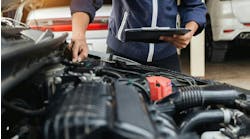Finding these small imperfections can be a challenge to even the most talented drivability technician. Verifying the ability of the engine to seal and compress the air/fuel mixture can be an especially time consuming task. Let's see if we can come up with a few ways to reduce that time spent.
This venerable tool, in informed hands, still can find issues with low compression, weak valves/valve springs and restrictions to air flow in a lot less time than other methods might require. Many you will find still on the tool trucks actually doubled as a fuel pressure tester back in the days of carbureted engines and have a large, easy-to-read faces.
When connecting to the engine, try to keep the gauge as close to the source of vacuum as possible to get the most accurate response to any changes that might be occurring. The further away you get, the more the connecting rubber hose will dampen fluctuations in pressure.
If you suspect a weak cylinder, this should be the first tool you reach for.
The next tool most of us reach for when we suspect a problem in cylinder integrity is the trusty mechanical compression tester. This tool measures the peak pressure created in the tested cylinder and is a general indicator of the overall health of that cylinder.To recap its use for our younger readers, the engine is first disabled so it will crank but not start. (The fuel system should always be taken offline to avoid over-fueling the cylinders whenever you perform a test that requires a "crank-no start.") A dry test is performed first by inserting the tester in place of each spark plug and spinning the engine over with the starter while holding the throttle plate in the wide-open position.
The peak gauge reading is recorded for each cylinder for later comparison to specification and to each other. If a low cylinder reading is recorded, the test is repeated, but this time a small amount of engine oil is added to the tested cylinder (a teaspoon or so is all that is needed). This is called a wet test and is used to determine whether the loss of sealing and the corresponding low-pressure reading is a result of a problem in the valve train or the piston ring-to-cylinder seal.
If pressure readings fail to improve, the top end's ability to close off the combustion chamber is suspect.
An alternative to the wet compression test is the cylinder leak down test. This method uses a special tool with two pressure gauges. Shop air is fed into one side of the tool, and the other is connected to the cylinder in place of the spark plug. The tested cylinder is brought to top dead center (TDC) of its compression stroke and then pressurized with the tool.This method has its benefits and drawbacks. The cause of the loss can be readily identified by listening for the escaping air in the throttle body (intake valves), the tailpipe (exhaust valves) and the oil fill (piston/rings), adjacent cylinders or the radiator (cylinder head gasket).
The drawback is a matter of safety. The engine must be held in place while testing, so be careful should your hand or tool slip with the cylinder under pressure.Performing traditional compression and leak down tests, though, can take a substantial amount of time: time you may or may not be able to justify to your customer when charging them for your diagnostic efforts. And there are more and more instances of intermittent sealing resulting in enough compression loss to cause a misfire you might not be able to duplicate at cranking speeds. Not to worry, though; there are alternatives.
Current Draw Equals Compression
Do you own a digital storage oscilloscope (DSO)? If you do, you own a powerful engine diagnostic tool. With the right accessories, you can perform a variety of engine tests that will help you identify issues with cylinder sealing, and in a lot less time than the conventional methods we talked about earlier.
One of the simplest methods for quickly checking the engine's ability to seal and squeeze is called the relative compression test. It uses your DSO and the high amp measuring clamp many come with as an included accessory, and it takes only a few minutes to perform.The resulting pattern on a scope is similar to that of a fuel pump current trace, but with low compression cylinders showing up as lower current peaks in the trace. Add a trigger to the No. 1 cylinder, and you can use firing order to easily identify those cylinders that are suspect.
Here's a related tip for you. The trigger line (when triggering off of the ignition system) should cross the current pattern just before the peak. As the peak occurs at TDC compression, this is a one way to see if the spark is happening at the right time. Keep in mind, though, that this is a relative test, comparing all the cylinders to each other. If a condition exists (incorrect cam timing, for example) that would result in lower pressure in all cylinders, it still would produce a pattern that was even across the trace.However, the difference in current between the lows and highs would not be as pronounced as it is on a healthy engine. And just like when you're ready to use any scope technique, try out this method on several "known good" engines to get a feel for what a normal pattern looks like.
An Alternative To Current
Testing relative compression doesn't have to be limited to current, though. A popular scope accessory for testing engine sealing is the SenX FirstLook pressure sensor. This sensor uses a piezoelectric crystal that reacts to pressure change and can be used to detect those changes in the exhaust pressure pulses (by inserting the sensor in the tailpipe) that normally result from cylinders that aren't pumping the same as their sisters.
The voltage output is best viewed by selecting a low AC voltage scaling, or using the AC coupling feature on your scope if it is so equipped. Time divisions are the same as the current draw test so keep it set at 100 ms per division. Of course, the next step is to crank the engine and lock in the pattern.With these tests, we're not focusing on minor discrepancies. A weak cylinder will stand out from the rest.
An advantage to the FirstLook sensor is the ability to quickly isolate the cause of any detected loss of sealing to the top or bottom end of the engine. By simply moving the sensor to the oil dipstick tube and cranking the engine through one more time, you will trace the pressure changes in the bottom half of the engine.And what affects that do you think? If you said piston/ring condition, you'd be on the right track. As the piston moves downward, pressure builds up below it. If the rings aren't sealing they way they should, the lower generated pressure will be obvious in the pattern. If no change is seen, then the loss of cylinder sealing is in the top half of the engine. In a matter of a few minutes, you've gotten the information you need to go back to your customer and justify the cost of a more detailed inspection.
Many talented technicians have learned to use the FirstLook sensor to further identify top end loss to the intake and/or exhaust valves, or detect intermittent sealing caused by sticking valves, bad seats, even carbon deposits. They do it by close inspection of the intake manifold vacuum and exhaust pressure pulse patterns, taken while cranking or with the engine running. They've developed their skills by investing the time in their personal training and by taking advantage of every opportunity to connect their scope to a good car.
If You Could Only See
If you've been around for a while, you likely are familiar with the running compression test where each individual cylinder's compression is tested while the engine is actually running. This pressure is substantially lower than a static compression test, but when used as a comparison can help detect problems with air flow through the engine. But like its static cousin, it cannot detect intermittent sealing issues like the use of the pressure sensors can.
Now imagine you can actually monitor the pressure changes in each cylinder over time, plotting it out like a graph that will show you how the pressure varies throughout the entire 720-degree four-stroke cycle. You can by using an in-cylinder pressure transducer and your scope. This accessory is available from a number of sources like Fluke, Pico and Automotive Test Solutions. It is installed into the cylinder to be tested in place of the spark plug, and cranking or running the engine and recording the resulting pattern.
This pattern can be used to learn a lot about how the cylinder is performing. You can use this method to monitor peak pressure over time to detect an intermittent sealing issue, identify valve/valve seat sealing problems, verify cam timing and more. Connecting a pressure transducer instead of your mechanical compression tester will net lots more information for the same amount of work.
Many of these transducers can be used to measure pressure change just as the FirstLook sensor does and are flexible enough to measure over a wide range of pressure and/or vacuum. Most also can be used to measure fluid pressure and are excellent tools for diagnosing fuel delivery and injector performance. But you can read about that in a separate article in this issue of Motor Age.
And for more information, including how-to videos on the procedures introduced in this article, log on to http://MotorAge.com and click the Community tab. There, you can access past print features, current blogs and other resources all of which are designed to help make your life in the bay easier.



